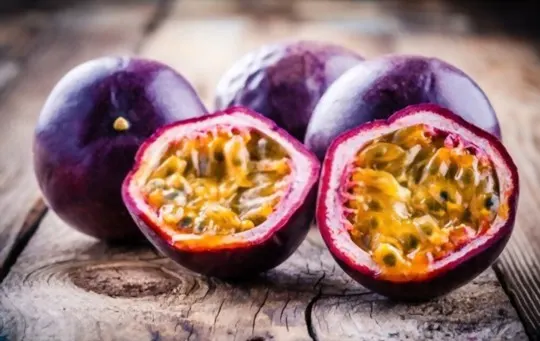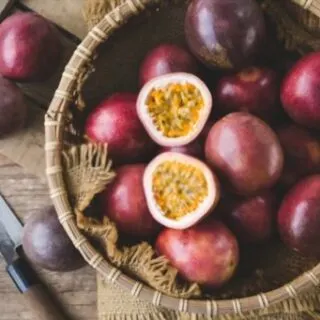If you’ve ever encountered a passion fruit, chances are that the enigmatic oval shape has caught your eye.
You may have even taken the opportunity to pick it up and admire its smooth yellow or purple exterior. But what does this exotic fruit actually taste like?
Some people think it tastes sweet, some describe its flavor as tart, while others say that it has notes of apricot and citrus.
To settle this argument once and for all, we’ve created an in-depth guide to everything you need to know about passion fruit – from its history and nutrition benefits to exciting recipes!
Read on to explore this tropical treasure in more detail…
What is Passion Fruit?

Passion fruit is a tropical fruit that is bursting with flavor and complexity.
This unique fruit is packed with tiny seeds and a juicy pulp that has a tart yet sweet taste, making it a popular ingredient in desserts and beverages.
The intricate flavor of passion fruit comes from its high concentration of acids, like tartaric and citric acid, as well as a range of essential oils.
When you cut into a passion fruit, its vibrant yellow or purple flesh has a thick, jelly-like consistency that adds a unique texture to any recipe.
Aside from its delicious taste, passion fruit is also packed with benefits.
It is a rich source of vitamins A and C, fiber, and antioxidants, making it the perfect addition to your daily diet.
So, if you’re looking to spice up your meal routine, give passion fruit a try and enjoy its burst of flavor and health benefits.
What Does Passion Fruit Taste Like?

Passion fruit is a tropical fruit that has a unique taste and aroma resembling a combination of sweet and tart flavors.
The taste of passion fruit depends on various factors such as the variety, ripeness, and how it’s prepared.
Passion fruit has a distinctive flavor that is both sweet and tart, with a tropical, slightly musky aroma.
The fruit is slightly acidic and has a juicy, gelatinous pulp containing small, crunchy seeds.
The taste of passion fruit is often described as exotic and refreshing, making it a popular ingredient in beverages, desserts, and sauces.
The fruit’s flavor is also affected by its ripeness; unripe fruit has a more tart flavor, while ripe fruit has a sweeter taste.
When using passion fruit in cooking, it’s recommended to balance its tartness with sugar or other sweeteners.
Pro Tip: To get the most flavor out of passion fruit, choose the ones that are heavy for their size, slightly wrinkled, and have a rich, fragrant smell.
Culinary Uses of Passion Fruit

Passion fruit is a tropical fruit with a distinctive flavor that is prized by chefs and food enthusiasts all over the world.
Its unique taste profile makes it a popular ingredient in cocktails, desserts, and savory dishes.
The fruit has a tangy, acidic flavor with a complex sweetness that is hard to describe.
The pulp of the fruit is often used in sauces, jams, and marinades, while the seeds are commonly used as a garnish on top of salads, cakes, and cocktails.
Here are some popular culinary uses of passion fruit:
- Passion Fruit Margarita: A tropical twist on a classic cocktail, the passion fruit margarita combines the tangy flavor of passion fruit with the bold taste of tequila.
- Passion Fruit Sorbet: A refreshing and light dessert, passion fruit sorbet is made by blending passion fruit pulp with sugar and water, then freezing the mixture until it reaches the desired texture.
- Passion Fruit Glaze: A versatile sweet and sour glaze that is perfect for glazing meat, vegetables, or fish.
Pro tip: When selecting passion fruit, look for fruits that are plump and heavy for their size, with wrinkled skin.
This indicates that the fruit is ripe and ready to eat.
How to Choose and Store Passion Fruit?

Passion fruit is a tropical fruit with a distinct tangy and fragrant flavor.
It has a tough outer shell and gelatinous pulp with plenty of edible seeds inside.
Here are some tips on how to choose and store passion fruit:
Choose a ripe passion fruit by looking for one that has a deep purple or yellow color and feels heavy for its size.
Avoid passion fruit that has cracks or bruises on the fruit’s surface or is too soft, as they can indicate over-ripeness or spoilage.
Store passion fruit in the refrigerator for up to two weeks.
If your passion fruit is not yet ripe, store it at room temperature until ripe, then transfer it to the refrigerator for longer-term storage.
To eat passion fruit, cut it in half and scoop out the pulp and seeds using a spoon.
You can eat passion fruit fresh or use it in fruit salads, smoothies, or desserts for a tropical twist.
Conclusion
In conclusion, passion fruit is a tropical fruit that is popular for its unique flavor, aroma, and nutritional benefits.
Passion fruit has a tart and sweet flavor, with a slightly sour taste and distinct aroma.
It can be eaten raw, used as a garnish or juice, or added to desserts, salads, and sauces.
Passion fruit is also high in fiber, vitamins A and C, and antioxidants, making it a healthy addition to your diet.
So, next time when you come across passion fruit, don’t hesitate to try it out and discover this amazing fruit’s unique and refreshing taste.

What Does Passion Fruit Taste Like? A Comprehensive Guide
Ingredients
- Passion fruit
- Ingredients from your selected recipes
Instructions
- Select ingredients that work well together.
- Use a recipe or method that will enhance their natural taste.
- Taste and adjust the recipe as needed to achieve the desired flavor.

Carrie is a food writer and editor with more than 15 years of experience. She has worked for some of the biggest names in the food industry, including Bon Appétit, Food & Wine, and Martha Stewart Living.
As the Editor in Chief of IntroChicago.com, Carrie oversees all of the content on the site. She also manages the team of contributing writers and editors, who help to create delicious recipes, helpful tips, and informative articles that you’ll find on the site.
A native of the Chicago area, Carrie is passionate about all things food. She loves trying new restaurants and experimenting with new recipes in her kitchen. She’s also a graduate of the Culinary Institute of America, so she knows a thing or two about food!
